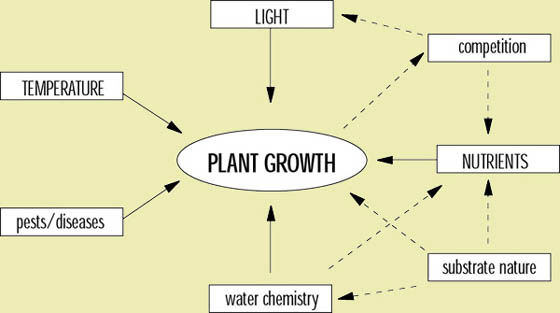 |
Aquatic Plant Propagation
|
 |
|
|
|
|
Plant growth is dependent upon several essential factors which govern the plant's growth rate directly and indirectly, according to their levels and availability to the plant. They are divided as follows:
|
| temperature | |
| light | |
| nutrients and fertilizers |
| substrate nature | |
| water chemistry | |
| pests and diseases | |
| competition |
Primary factors directly affect the mechanisms of plant growth. One or more secondary factors indirectly affect or moderate these growth mechanisms by affecting:
| plant health | |
| plant physiology, and | |
| availability of primary factors |
Interrelationships between primary (solid lines) and
secondary (dashed lines) factors on plant growth.

Availability of primary factors may be affected, for example, by reduction of available light or nutrients through competition from other plants or algae, or by water chemistry limiting the availability of micro-nutrients to the plant via oxidation of trace metals into insoluble precipitates.
Plant growth can be defined using the Liebig 'Law of the Minimum' which states that: 'The growth of a plant is dependant upon the foodstuff presented to it in minimum quantities...' (Salisbury and Ross 1992), i.e. a limiting factor. Therefore, we can suppose that if one or more factor is limiting, then growth rate will be dependant upon the level of that factor(s), irrespective of the fact that all other growth factors may be optimal.
The following pages provide an outline of those factors that should be addressed when cultivating aquatic macrophytes. Emphasis and specific examples will mainly deal with floating and submerged weeds of economic importance, such as: Eichhornia crassipes Solms., Salvinia molesta Mitchell, Pistia stratiotes L., Elodea canadensis (Michx.) Planch. and Myriophyllum species.
Finally,
a page outlining some general guidelines to
follow is included.